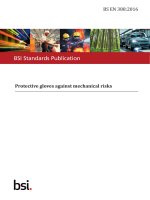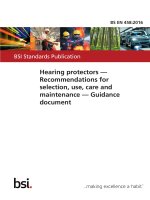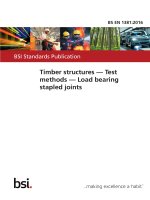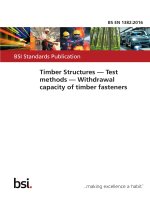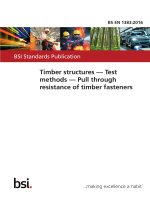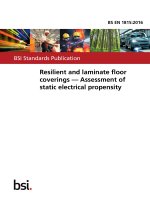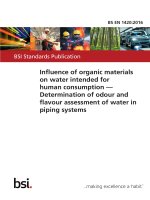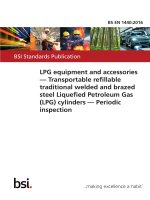Bsi bs en 14112 2016
Bạn đang xem bản rút gọn của tài liệu. Xem và tải ngay bản đầy đủ của tài liệu tại đây (1.82 MB, 24 trang )
BS EN 14112:2016
BSI Standards Publication
Fat and oil derivatives — Fatty
Acid Methyl Esters (FAME) —
Determination of oxidation
stability (accelerated oxidation
test)
BS EN 14112:2016
BRITISH STANDARD
National foreword
This British Standard is the UK implementation of EN 14112:2016.
It supersedes BS EN 14112:2003 which is withdrawn.
The UK participation in its preparation was entrusted to Technical
Committee AW/307, Oilseeds, animal and vegetable fats and oils and
their by-products.
A list of organizations represented on this committee can be
obtained on request to its secretary.
This publication does not purport to include all the necessary
provisions of a contract. Users are responsible for its correct
application.
© The British Standards Institution 2016.
Published by BSI Standards Limited 2016
ISBN 978 0 580 86291 5
ICS 67.200.10
Compliance with a British Standard cannot confer immunity from
legal obligations.
This British Standard was published under the authority of the
Standards Policy and Strategy Committee on 30 September 2016.
Amendments/corrigenda issued since publication
Date
Text affected
BS EN 14112:2016
EN 14112
EUROPEAN STANDARD
NORME EUROPÉENNE
EUROPÄISCHE NORM
September 2016
ICS 67.200.10
Supersedes EN 14112:2003
English Version
Fat and oil derivatives - Fatty Acid Methyl Esters (FAME) Determination of oxidation stability (accelerated oxidation
test)
Produits dérivés des corps gras - Esters méthyliques
d'acides gras (EMAG) - Détermination de la stabilité à
l'oxydation (Essai d'oxydation accélérée)
Erzeugnisse aus pflanzlichen und tierischen Fetten und
Ölen - Fettsäure-Methylester (FAME) - Bestimmung
der Oxidationsbeständigkeit (Beschleunigte
Oxydationsprüfung)
This European Standard was approved by CEN on 8 July 2016.
CEN members are bound to comply with the CEN/CENELEC Internal Regulations which stipulate the conditions for giving this
European Standard the status of a national standard without any alteration. Up-to-date lists and bibliographical references
concerning such national standards may be obtained on application to the CEN-CENELEC Management Centre or to any CEN
member.
This European Standard exists in three official versions (English, French, German). A version in any other language made by
translation under the responsibility of a CEN member into its own language and notified to the CEN-CENELEC Management
Centre has the same status as the official versions.
CEN members are the national standards bodies of Austria, Belgium, Bulgaria, Croatia, Cyprus, Czech Republic, Denmark, Estonia,
Finland, Former Yugoslav Republic of Macedonia, France, Germany, Greece, Hungary, Iceland, Ireland, Italy, Latvia, Lithuania,
Luxembourg, Malta, Netherlands, Norway, Poland, Portugal, Romania, Slovakia, Slovenia, Spain, Sweden, Switzerland, Turkey and
United Kingdom.
EUROPEAN COMMITTEE FOR STANDARDIZATION
COMITÉ EUROPÉEN DE NORMALISATION
EUROPÄISCHES KOMITEE FÜR NORMUNG
CEN-CENELEC Management Centre: Avenue Marnix 17, B-1000 Brussels
© 2016 CEN
All rights of exploitation in any form and by any means reserved
worldwide for CEN national Members.
Ref. No. EN 14112:2016 E
BS EN 14112:2016
EN 14112:2016 (E)
Contents
Page
European foreword....................................................................................................................................................... 3
Introduction .................................................................................................................................................................... 4
1
Scope .................................................................................................................................................................... 5
2
Normative references .................................................................................................................................... 5
3
Terms and definitions ................................................................................................................................... 5
4
Principle ............................................................................................................................................................. 5
5
Reagents and materials................................................................................................................................. 6
6
Apparatus........................................................................................................................................................... 6
7
Sampling ............................................................................................................................................................. 8
8
8.1
8.2
8.2.1
8.2.2
Preparation of measurement ..................................................................................................................... 9
Preparation of test sample .......................................................................................................................... 9
Preparation of apparatus ............................................................................................................................. 9
Cleaning procedure ........................................................................................................................................ 9
Temperature correction ............................................................................................................................... 9
9
Measurement ................................................................................................................................................. 10
10
10.1
10.2
Calculation and Evaluation ....................................................................................................................... 13
Automatic evaluation.................................................................................................................................. 13
Manual evaluation ....................................................................................................................................... 15
11
Expression of results................................................................................................................................... 16
12
12.1
12.2
12.3
Precision .......................................................................................................................................................... 16
General ............................................................................................................................................................. 16
Repeatability, r .............................................................................................................................................. 16
Reproducibility, R ........................................................................................................................................ 16
13
Test report ...................................................................................................................................................... 16
Annex A (informative) Background of the method ......................................................................................... 18
Annex B (informative) Results of an Interlaboratory Study ........................................................................ 19
Bibliography ................................................................................................................................................................. 20
2
BS EN 14112:2016
EN 14112:2016 (E)
European foreword
This document (EN 14112:2016) has been prepared by Technical Committee CEN/TC 307 “Oilseeds, vegetable
and animal fats and oils and their by-products - Methods of sampling and analysis”, the secretariat of which is
held by AFNOR.
This European Standard shall be given the status of a national standard, either by publication of an identical
text or by endorsement, at the latest by March 2017, and conflicting national standards shall be withdrawn at
the latest by March 2017.
Attention is drawn to the possibility that some of the elements of this document may be the subject of patent
rights. CEN shall not be held responsible for identifying any or all such patent rights
This document supersedes EN 14112:2003.
Significant changes between this document and EN 14112:2003 are:
a) the limitation of the scope of the method to a maximum induction period of 48 h, reflecting the precision
range of the method;
b) indication of a potential alteration of the induction period in the presence of cetane enhancers;
c) editorial changes in order to clarify the test procedure;
d) addition of Clause 2 – Normative references;
e) addition of Clause 11 – Expression of results;
f)
background information on the method added as Annex A.
According to the CEN-CENELEC Internal Regulations, the national standards organisations of the following
countries are bound to implement this European Standard: Austria, Belgium, Bulgaria, Croatia, Cyprus, Czech
Republic, Denmark, Estonia, Finland, Former Yugoslav Republic of Macedonia, France, Germany, Greece,
Hungary, Iceland, Ireland, Italy, Latvia, Lithuania, Luxembourg, Malta, Netherlands, Norway, Poland, Portugal,
Romania, Slovakia, Slovenia, Spain, Sweden, Switzerland, Turkey and the United Kingdom.
3
BS EN 14112:2016
EN 14112:2016 (E)
Introduction
This document is based on EN 14112:2003, which was specifically adapted for the determination of oxidation
stability of fatty acid methyl esters (FAME). This method had been developed under CEN/TC 307 (Fats and
oils).
The modifications as given in this document address the field experience with this method made since its
introduction as a standard test method. Editorial changes are made in order to specify some aspects of the test.
Additionally, the cleaning procedure is modified based on field experience.
4
BS EN 14112:2016
EN 14112:2016 (E)
1 Scope
This European Standard specifies a method for the determination of the oxidation stability of fatty acid methyl
esters (FAME) at 110 °C, by means of measuring the induction period up to 48 h.
NOTE 1
EN 15751 [1] describes a similar test method for oxidation stability determination of pure fatty acid methyl
esters and of blends of FAME with petroleum-based diesel containing 2 % (V/V) of FAME at minimum.
NOTE 2
The precision statement of this test method was determined in a Round Robin exercise with induction periods
up to 8,5 h, thus covering the limit value in EN 14214. Results from precision studies on EN 15751 indicate that the
precision statement is valid for induction periods up to 48 h but not for higher values.
NOTE 3
Limited studies on EN 15751 with EHN (2-ethyl hexyl nitrate) on FAME blends indicated that the stability is
reduced to an extent which is within the reproducibility of the test method. It is likely that the oxidation stability of pure
FAMEs is also reduced in the presence of EHN when EN 14112 is used for testing.
2 Normative references
The following documents, in whole or in part, are normatively referenced in this document and are
indispensable for its application. For dated references, only the edition cited applies. For undated references,
the latest edition of the referenced document (including any amendments) applies.
EN ISO 3170, Petroleum liquids - Manual sampling (ISO 3170)
EN ISO 3171, Petroleum liquids - Automatic pipeline sampling (ISO 3171)
3 Terms and definitions
For the purposes of this document, the following terms and definitions apply.
3.1
induction period
time which passes between the moment when the measurement is started and the moment when the formation
of oxidation products begins to increase rapidly
3.2
oxidation stability
induction period determined according to the procedure specified in this European Standard, expressed in
hours
4 Principle
A stream of purified (dried) air is passed through the sample which has been heated to the target temperature
which is 110 °C in the usual application of the method. Volatile compounds are formed during the oxidation
process. They are, passed together with the air into a flask containing demineralized or distilled water,
equipped with a conductivity electrode. The electrode is connected to a measuring and recording device. It
indicates the end of the induction period by rapid increase of the conductivity due to the dissociation of volatile
carboxylic acids produced during the oxidation process and absorbed in the water. For more details on the
background of the method see Annex A.
5
BS EN 14112:2016
EN 14112:2016 (E)
5 Reagents and materials
Use only reagents of analytical grade and distilled or demineralized water.
5.1
Ternary solvent mixture, consisting of methanol/toluene/acetone 1:1:1 (by volume).
5.2
Alkaline laboratory glass cleaning solution.
5.3
2-Propanol.
6 Apparatus
Usual laboratory equipment and glassware, together with the following:
6.1 Device for the determination of oxidation stability, comprising the following parts (see Figures 1
and 2) 1).
6.1.1 Air filter, comprising a tube fitted with filter paper at the ends and filled with a molecular sieve (6.6),
connected to the suction end of a pump.
6.1.2
6.1.3
Gas membrane pump, with an adjustable flow rate of (10 ± 1,0) l/h.
Reaction vessels of borosilicate glass, provided with a sealing cap.
The sealing cap shall be fitted with a gas inlet and outlet tube.
6.1.4 Closed measurement cells, of approximately 150 ml capacity, with an air inlet tube extending to the
bottom inside of the vessel. The cell shall have ventilation holes at the top.
6.1.5 Electrodes, for measuring conductivity within a range of 0 μS/cm to 300 μS/cm aligned with the
dimensions of the measurement cell (6.1.4).
6.1.6
Measuring and recording apparatus, comprising:
a) an amplifier; and
b) a recorder registering the signal of each of the electrodes (6.1.5).
6.1.7 Thyristor and contact thermometer graduated in 0,1 °C or Pt 100 element to measure the block
temperature, with attachments for relay connection and an adjustable heating element; temperature scale 0 °C
to 150 °C.
1) Rancimat is the trade name of a product supplied by Metrohm AG, Herisau, Switzerland; OSI is the trade name of a product supplied
by Omnion Inc., Rockland, Massachusetts, USA. This information is given for the convenience of users of this European Standard and
does not constitute an endorsement by CEN or CENELEC of the products named. Equivalent products may be used if they can be shown
to lead to the same results.
6
BS EN 14112:2016
EN 14112:2016 (E)
6.1.8 Heating block, made of cast aluminium, adjustable to a temperature up to (150 ± 0,1) °C. The block
shall be provided with holes for the reaction vessels (6.1.3) and an aperture for the contact thermometer
(6.1.7).
Alternatively a heating bath may be used, filled with oil suitable for temperatures up to 150 °C, and adjustable
to the nearest 0,1 °C.
6.2 Certified and calibrated thermometer or Pt100 element, with a temperature range up to 150 °C,
graduated in 0,1 °C.
Key
1 air filter (6.1.1)
2 gas membrane pump with flow rate control (6.1.2)
3 reaction vessel (6.1.3)
4 measurement cell (6.1.4)
5
6
7
8
electrode (6.1.5)
measuring and recording apparatus (6.1.6)
thyristor and contact thermometer (6.1.7)
heating block (6.1.8)
Figure 1 — Apparatus
7
BS EN 14112:2016
EN 14112:2016 (E)
Dimensions in mm
Key
1 measuring vessel
2 electrode
3 distilled/demineralized water
4 reaction vessel
5
6
7
sample
heating block
air inlet
Figure 2 — Diagrammatic representation of heating block, reaction vessel and measurement cell
6.3
Measuring pipettes and/or measuring cylinders.
6.4
Oven, adjustable to a temperature up to (150 ± 3) °C.
6.5
Connecting hoses, flexible and made of inert material [polytetrafluoroethylene (PTFE) or silicone].
6.6 Molecular sieve, with moisture indicator, pore size 0,3 nm, dried in an oven set at 150 °C and cooled
down to room temperature in a desiccator before use.
6.7
Balance, capable of weighing with an accuracy of ± 0,1 g or less.
7 Sampling
Unless otherwise specified, sampling shall be conducted according to EN ISO 3170 or EN ISO 3171 and/or in
accordance with the requirements of national standards or regulations for the sampling.
It is important that the laboratory receives a sample which is truly representative and has not been damaged or
changed during transport and storage.
Store the sample in the dark at about 4 °C and measure it as soon as possible after receipt.
8
BS EN 14112:2016
EN 14112:2016 (E)
8 Preparation of measurement
8.1 Preparation of test sample
In order to ensure a consistent test condition, all samples shall be treated in the way described below:
— take the required quantity from the centre of the carefully homogenized sample using a pipette;
— analyse the samples immediately after sample preparation.
8.2 Preparation of apparatus
8.2.1 Cleaning procedure
The use of new disposable reaction vessels, air inlet tubes and connecting hoses is recommended in order to
save the cleaning procedure.
Sealing caps, measuring cells and electrodes shall be cleaned with 2-Propanol in order to remove organic
residues. The connecting hoses should also be washed in the same manner if not replaced.
Rinse with tap water and finally with demineralized or distilled water. Dry the cleaned parts in an oven at 80 °C
for at least 2 h. The temperature may not exceed 80 °C due to elastomer stability.
Residual fuel and aging products from the previous experiment and the solvent from the cleaning may remain
adsorbed in the elastomers and shall be removed. A drying time of 2 h ensures that all volatile compounds are
removed.
In case of reuse, purge the empty reaction vessels and the air inlet tubes at least three times with ternary
solvent mixture (5.1) in order to remove residual fuel and adherent organic ageing residues. The last solvent
portion should remain colourless.
Rinse with 2-Propanol and tap water. Put the inlet tube into the reaction vessel and fill completely with an
aqueous alkaline laboratory cleaning solution.
Store the vessels at room temperature overnight.
Rinse the purified vessels and their inlet tubes thoroughly with tap water and finally with demineralized or
distilled water. Dry them in an oven for at least 2 h at 80 °C.
In case of doubt, the cleanliness of the sealing caps and connecting hoses can be checked by running a blank
sample under standard test conditions. In this case the conductivity increase shall not exceed 10 μS/cm
within 5 h.
8.2.2 Temperature correction
8.2.2.1 General
Any deviation between the temperature of the fuel sample in the test vessel and the temperature of the heating
block or the heating bath has a significant impact on the result. In order to ensure that the correct
measurement temperature is used, the difference between the temperature of the sample and the temperature
of the heating block, ΔT, needs to be determined. For this determination a calibrated external temperature
sensor is used.
The temperature correction always needs to be conducted when the test is carried out at a different
temperature than before.
8.2.2.2 Procedure
Switch on the heating block and wait until the target temperature is reached and is stable.
9
BS EN 14112:2016
EN 14112:2016 (E)
Fill one reaction vessel with 5 g thermo-stable oil. Insert the temperature sensor through the cap into the
reaction vessel. Use distance clips to keep the sensor away from the air inlet. The sensor should touch the
bottom of the vessel.
Insert the complete vessel into the heating block and connect the air supply.
If the value of the measured temperature is constant, calculate ΔT:
T Tblock − Tsensor
∆
=
where
ΔT
Tblock
Tsensor
is the temperature difference between heating block and sample;
is the temperature of the heating block;
is the sample temperature in the reaction vessel measured by the sensor.
Adjust the temperature of the heating block according to Formula (2):
T=
block Ttarget + ∆T
where
Ttarget
EXAMPLE
(1)
(2)
is the intended measurement temperature.
Ttarget is 110 °C. If a ΔT of + 2 °C is determined, the temperature of the heating block has to be set to 112 °C.
After this temperature correction, the measured temperature in the reaction vessel should be equal to the
target temperature.
9 Measurement
9.1 Set up the apparatus as shown in Figure 1. If commercially available equipment is used, follow the
manufacturer’s instructions.
9.2 Attach the membrane pump (6.1.2) and adjust the air flow to exactly (10 ± 1) l/h. Switch off the pump.
Dedicated instruments are usually equipped with automatic flow control.
9.3 Bring the heating block (6.1.8) to a temperature such that the required test temperature (usually 110 °C,
but see 8.2.2) is reached in the test tube(s), using the thyristor and the contact thermometer (6.1.7) or by using
an electronic temperature controller. The temperature shall be kept constant (±0,1 °C) during the test period
(see also 8.2.2).
If a heating bath (6.1.8) is used, heat to the desired temperature and control the temperature according to 8.2.2.
9.4 Fill the measurement cells (6.1.4) with 60 ml of distilled or demineralized water using a measuring
pipette (6.3).
9.5
9.5.1
Check the electrodes (6.1.5) and adjust their signals using a calibration potentiometer.
The data are recorded by the software of the PC.
9.5.2 If an evaluation using a PC is not possible, proceed as follows: Check the electrodes (6.1.5) and adjust
their signals to the zero axis of the recorder paper using a calibration potentiometer. Set the paper feed to
10 mm/h and the measuring frequency to one acquisition per 30 s. Set the measuring value of 200 μS/cm at the
maximum result of 100 %. If it is not possible to adjust the paper feed to 10 mm/h, use 20 mm/h. This shall be
reported on the recorder paper.
10
BS EN 14112:2016
EN 14112:2016 (E)
9.6
Weigh (3,0 ± 0,01) g of the conditioned sample (see 8.1) into a reaction vessel using a pipette (6.3).
9.7 When the test temperature is reached, switch on the membrane pump (6.1.2) and set the air flow to
exactly (10 ± 1) l/h. Connect the air inlet tubes and outlet tubes to the reaction vessels and the measurement
cells, using the connecting hoses (6.5).
9.8 Place the reaction vessel with the sealing cap (6.1.3) into the corresponding hole in the heating block or
into the heating bath (6.1.8).
The preparation steps 9.7 and 9.8 shall be carried out as fast as possible. Then immediately start the automatic
data recording or note the start time on the recorder paper.
9.9
The measurement may be terminated:
— when the signal has reached 100 % of the recorded scale, usually 200 μS/cm (see Figure 3, upper diagram);
or
— when the conductivity curve flattens again after exceeding the induction period (see Figure 3, lower
diagram). Care should be taken to ensure that the test is not terminated before the curve has flattened
sufficiently to fit an accurate second tangent; or
— after 48 h of testing time.
11
BS EN 14112:2016
EN 14112:2016 (E)
a)
b)
Figure 3 — Measurement termination indications
9.10 During the determination, check the following parameters:
a) the setting of the flow meter. Adjust where necessary in order to ensure a constant flow;
b) the colour of the molecular sieve (6.6) of the air filter. Repeat measurements when the molecular sieve
changes colour during the test. It is recommended to exchange the molecular sieve prior to each run.
NOTE 1
At temperatures above approximately 25 °C, volatile carboxylic acids can evaporate from the measurement
cell. This may lead to a decrease of the conductivity of the aqueous solution, thus causing significant deviations of the
conductivity curve (see Bibliographical Reference [2]).
NOTE 2
A rapid conductivity increase immediately after starting the test and before reaching the induction period may
indicate insufficient cleaning of the sealing caps or connecting hoses (evaporation of residual volatile compounds from the
12
BS EN 14112:2016
EN 14112:2016 (E)
elastomers) (see Figure 5). The cleanliness can be validated according to the procedure given in 8.2.1, 1st paragraph. Also
fuels that contain volatile acids can unexpectedly show a rapid initial conductivity increase (see Figure 6).
10 Calculation and Evaluation
10.1 Automatic evaluation
The automatic evaluation as given by the equipment manufacturers may be used if the second derivative of the
conductivity curve shows a clear maximum. This is generally the case if pure FAME and diesel/FAME blends
with a FAME content equals or higher than 10 % (V/V) are investigated (see Figure 4, upper diagram).
If the second derivative of the conductivity curve is noisy and no clear maximum can be recognized, the manual
evaluation (10.2) of the conductivity curve itself shall be applied (see Figure 4, lower diagram).
Software settings are recommended that permit simultaneous display of the conductivity curve and its second
derivative in order to enable the operator to check the automatically calculated value for the induction period.
13
BS EN 14112:2016
EN 14112:2016 (E)
a)
b)
Figure 4 — Evaluation indications
14
BS EN 14112:2016
EN 14112:2016 (E)
Figure 5 — Indication for insufficient cleaning
Figure 6 — Indication for rapid initial conductivity increase
10.2 Manual evaluation
Set the first tangent to the flattest part of the slowly increasing conductivity curve. Great care shall be taken to
fit the best possible tangent line, e.g. by using an enlarged presentation of the original graph. Some instruments
supply a zoom-function to accomplish this. The second tangent is set after exceeding the inflexion point at the
steepest part of the conductivity curve (see Figure 3).
The induction period is obtained from the intersection point of both tangents.
15
BS EN 14112:2016
EN 14112:2016 (E)
11 Expression of results
Report the induction period, obtained from 10.1 or 10.2, in hours and rounded to the nearest 0,1 h.
If the induction period exceeds 48 h and the measurement is stopped, the result shall be reported as “> 48 h”.
12 Precision
12.1 General
An interlaboratory test organized in 2000 at European level with the participation of 8 laboratories was
conducted on 8 samples at a test temperature of 110 °C and gave the statistical results indicated in Annex B.
Results from the calculation of precision estimates used shall be rounded to the nearest 0,1 h.
12.2 Repeatability, r
The difference between two test results, obtained by the same operator with the same apparatus under
constant operating conditions on identical test material would, in the long run, in the normal and correct
operation of the test method, exceed the values calculated from the following formula in absolute value only in
one case in 20.
r= 0,09 ⋅ X + 0,16
where
(3)
X is the mean of the two results.
12.3 Reproducibility, R
The difference between two single and independent test results, obtained by different operators working in
different laboratories on identical test material would, in the long run, in the normal and correct operation of
the test method, exceed the values calculated from the following formula in absolute value only in one case in
20.
R= 0,26 ⋅ X + 0,23
where
X
(4)
is the mean of the two results.
13 Test report
The test report shall at least specify:
a) a reference to this European standard (i.e. EN 14112:2016);
b) the type and complete identification of the product tested;
c) the sampling method used if known (see Clause 7);
d) the temperature at which the determination was carried out;
e) the test result(s) obtained (see Clause 11), or if the repeatability has been checked, the final quoted result
obtained;
16
BS EN 14112:2016
EN 14112:2016 (E)
f)
all operating details not specified in this European Standard, or regarded as optional, together with details
of any incidents which may have influenced the test result(s);
g) any deviation, by agreement or otherwise, from the procedure specified;
h) the date of test.
17
BS EN 14112:2016
EN 14112:2016 (E)
Annex A
(informative)
Background of the method
It has been established that the phenomenon of fuel ageing consists of two consecutive phases, starting with
the depletion of the ageing reserve with few chemical changes to the bulk material, followed by the fuel ageing
process itself during which the fuel is badly decomposed, forming ageing polymers and acids.
The first phase, the depletion of the ageing reserve, can be accurately monitored by means of accelerated
oxidation tests EN 14112 and EN 15751. Both tests measure the induction period, i.e. how long the fuel is stable
under standardized laboratory conditions, and monitor fuel oxidation by tracking conductivity. The
conductivity is recorded in a cell equipped with an electrode and filled with water. This cell is constantly
flushed with the air that was passed through the fuel sample before. As soon as the fuel oxidizes and the first
ageing acids are formed, the air stream carries volatile organic acids into the measurement cell. The end of the
induction period is indicated by a strong conductivity increase.
18
BS EN 14112:2016
EN 14112:2016 (E)
Annex B
(informative)
Results of an Interlaboratory Study
A European collaborative study involving 8 laboratories in 5 countries was conducted on 8 samples:
— Sample 1: mixture of rapeseed oil and sunflower oil FAME (not distilled, 1 month old);
— Sample 2: frying oil FAME (not distilled, 1 month old);
— Sample 3: palm oil fraction (C16-C18) FAME (distilled, 1 month old);
— Sample 4: rapeseed oil FAME producer n°3 (not distilled, 1 month old);
— Sample 5: rapeseed oil FAME producer n°2 (distilled, 1 month old);
— Sample 6: sunflower oil FAME (distilled, 2 months old);
— Sample 7: rapeseed oil FAME producer n°1 (not distilled, 2 months old);
— Sample 8: rapeseed oil FAME - storage tank (4 months old).
The test was organized by CEN/TC 307/WG 1 in 2000 and the results obtained were subject to statistical
analysis in accordance with EN ISO 4259 to give the precision data shown in Table B.1.
Table B.1 — Thermal oxidation stability
Sample
N° of participating laboratories
1
2
3
4
5
6
7
8
8
8
8
8
8
8
8
8
N° of participating laboratories after eliminating outliers
Mean value (h)
5,42 8,48 0,92 5,64 1,20 2,90 4,87 0,97
Repeatability standard deviation
0,21 0,36 0,09 0,06 0,03 0,31 0,10 0,06
Repeatability limit, r
0,69 1,22 0,29 0,20 0,11 1,02 0,35 0,20
Reproducibility standard deviation
Reproducibility limit, R
7
7
7
6
6
7
6
7
0,36 0,71 0,16 0,44 0,08 0,34 0,63 0,14
1,20 2,39 0,52 1,53 0,29 1,14 2,17 0,46
19
BS EN 14112:2016
EN 14112:2016 (E)
Bibliography
[1]
[2]
[3]
[4]
[5]
[6]
[7]
[8]
20
EN 15751:2014, Automotive fuels - Fatty acid methyl ester (FAME) fuel and blends with diesel fuel Determination of oxidation stability by accelerated oxidation method
DE MAN J.M. FAN TIE und DE MAN, L. J. Am. Oil Chem. Soc. 1987, 64 p. 993
HADORN. H. and ZÜRCHNER, K. Dtsch. Lebensmitt. Rundsch. 1974, 70 p. 57
PARDUN. H. and KROLL, E. Fette, Seifen. Anstrichmittel. 1972, 74 p. 366
EN ISO 6886, Animal and vegetable fats and oils - Determination of oxidative stability (accelerated
oxidation test) (ISO 6886)
EN 14214, Liquid petroleum products —Fatty acid methyl esters (FAME) for use in diesel engines and
heating applications —Requirements and test methods
EN ISO 3696, Water for analytical laboratory use - Specification and test methods (ISO 3696)
EN ISO 4259, Petroleum products - Determination and application of precision data in relation to methods
of test (ISO 4259)
This page deliberately left blank
NO COPYING WITHOUT BSI PERMISSION EXCEPT AS PERMITTED BY COPYRIGHT LAW
British Standards Institution (BSI)
BSI is the national body responsible for preparing British Standards and other
standards-related publications, information and services.
BSI is incorporated by Royal Charter. British Standards and other standardization
products are published by BSI Standards Limited.
About us
Reproducing extracts
We bring together business, industry, government, consumers, innovators
and others to shape their combined experience and expertise into standards
-based solutions.
For permission to reproduce content from BSI publications contact the BSI
Copyright & Licensing team.
The knowledge embodied in our standards has been carefully assembled in
a dependable format and refined through our open consultation process.
Organizations of all sizes and across all sectors choose standards to help
them achieve their goals.
Information on standards
We can provide you with the knowledge that your organization needs
to succeed. Find out more about British Standards by visiting our website at
bsigroup.com/standards or contacting our Customer Services team or
Knowledge Centre.
Buying standards
You can buy and download PDF versions of BSI publications, including British
and adopted European and international standards, through our website at
bsigroup.com/shop, where hard copies can also be purchased.
If you need international and foreign standards from other Standards Development
Organizations, hard copies can be ordered from our Customer Services team.
Copyright in BSI publications
All the content in BSI publications, including British Standards, is the property
of and copyrighted by BSI or some person or entity that owns copyright in the
information used (such as the international standardization bodies) and has
formally licensed such information to BSI for commercial publication and use.
Save for the provisions below, you may not transfer, share or disseminate any
portion of the standard to any other person. You may not adapt, distribute,
commercially exploit, or publicly display the standard or any portion thereof in any
manner whatsoever without BSI’s prior written consent.
Storing and using standards
Standards purchased in soft copy format:
• A British Standard purchased in soft copy format is licensed to a sole named
user for personal or internal company use only.
• The standard may be stored on more than 1 device provided that it is accessible
by the sole named user only and that only 1 copy is accessed at any one time.
• A single paper copy may be printed for personal or internal company use only.
Standards purchased in hard copy format:
• A British Standard purchased in hard copy format is for personal or internal
company use only.
• It may not be further reproduced – in any format – to create an additional copy.
This includes scanning of the document.
If you need more than 1 copy of the document, or if you wish to share the
document on an internal network, you can save money by choosing a subscription
product (see ‘Subscriptions’).
Subscriptions
Our range of subscription services are designed to make using standards
easier for you. For further information on our subscription products go to
bsigroup.com/subscriptions.
With British Standards Online (BSOL) you’ll have instant access to over 55,000
British and adopted European and international standards from your desktop.
It’s available 24/7 and is refreshed daily so you’ll always be up to date.
You can keep in touch with standards developments and receive substantial
discounts on the purchase price of standards, both in single copy and subscription
format, by becoming a BSI Subscribing Member.
PLUS is an updating service exclusive to BSI Subscribing Members. You will
automatically receive the latest hard copy of your standards when they’re
revised or replaced.
To find out more about becoming a BSI Subscribing Member and the benefits
of membership, please visit bsigroup.com/shop.
With a Multi-User Network Licence (MUNL) you are able to host standards
publications on your intranet. Licences can cover as few or as many users as you
wish. With updates supplied as soon as they’re available, you can be sure your
documentation is current. For further information, email
Revisions
Our British Standards and other publications are updated by amendment or revision.
We continually improve the quality of our products and services to benefit your
business. If you find an inaccuracy or ambiguity within a British Standard or other
BSI publication please inform the Knowledge Centre.
Useful Contacts
Customer Services
Tel: +44 345 086 9001
Email (orders):
Email (enquiries):
Subscriptions
Tel: +44 345 086 9001
Email:
Knowledge Centre
Tel: +44 20 8996 7004
Email:
Copyright & Licensing
Tel: +44 20 8996 7070
Email:
BSI Group Headquarters
389 Chiswick High Road London W4 4AL UK

